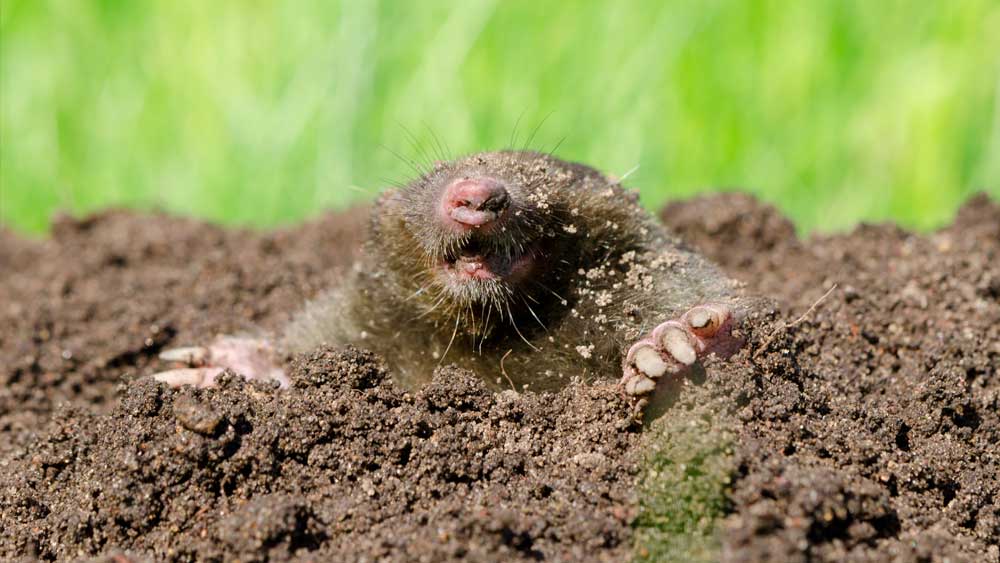Moles are known for digging. But how do they dig?
The mole excavates its burrow by backward strokes and lateral thrusts of the front feet. Loose earth is moved and pushed to the surface by thrusts of the front feet. In excavating shallow runs, the mole merely pushes up the earth to form a ridge, again by lateral thrusts of the front feet while the mole is turned partly on its side.”1
If no one whacks them, then moles go about their daily business, eating and traveling underground.
Moles play a beneficial role in the management of soil and the control of undesirable grubs and insects, but homeowners may object to molehills and the shallow tunnels moles create. … Moles are insectivores, not rodents, and are related to shrews. Their diet consists mainly of grubs, beetles, beetle larvae, and worms found in the soil. Moles eat from 70 to 100 percent of their weight each day. The tremendous amount of energy expended in plowing through soil requires a correspondingly large amount of food to supply that energy. Moles do not hibernate but are more or less active all seasons of the year. They are busiest finding and storing foods during rainy periods in summer.2
And moles, like all animals, are hungry. They need food to eat! They hunt earthworms, insect grubs, and other underground prey. In doing so, they serve the subterranean near-surface soil ecosystem.
Because of their food requirements, moles must cover a larger area than do most animals that live underground. Three to five moles per acre are considered a high population for most areas. Moles prefer to hunt in loose, moist soil that is rich in grubs and earthworms. This preference accounts for the mole's attraction to lawns and parks. Moles play a beneficial role in the management of soil and the control of undesirable grubs and insects. By tunneling and shifting soil particles, moles permit better aeration of the soil, help dry out sod, and enable humus (organic matter) to travel deeper into the soil. Their tunneling also allows subsoil material to be moved closer to the surface, where nutrients may be more available to plant roots.2
Who taught the humble mole to do such underground digging and taught them to do it so successfully that moles live all over much of America? Who equipped the mole with the anatomy it needs to do this subterranean work?
As simple as it seems, digging underground is an art and a science.3 Those who intelligently design and/or carefully operate oil-drilling equipment can appreciate the digging powers of moles! Innovative petroleum engineers deserve to be appreciated for their underground earth-burrowing technology.
So, if you think serious underground digging is “simple,” then try drilling for oil—or mine minerals from the earth!
But oil-drilling equipment cannot reproduce itself into generation-after-generation families of their kind. Yet moles reproduce successfully, all around America, and we don’t notice or appreciate it. God, however, deserves praise for equipping the humble mole for its down-to-earth (or rather, down-under-the-earth) station in life.
Moles are created to dig and they do to God’s glory! Their Creator is worthy of worship.4
So, whether we are experiencing business-as-usual—or whether we are weathering an emergency—we should be sure to credit God, not natural causes, for the design of moles’ digging capabilities. We should seek to harness each day as a day of worshipping our soon-coming Lord Jesus, the Maker of Heaven and Earth.5
References
1. Schmidly, D. J. 2004. The Mammals of Texas. University of Texas Press, 60.
2. Williams, L. M., Brittingham, M. C. Moles. Pennsylvania State University Extension. Posted on psu.edu June 10, 2007, accessed March 24, 2020.
3. Clarey, T. 2013. Oil, Fracking, and a Recent Global Flood. Acts & Facts. 42 (10): 14-15.
4. Revelation 4:11.
5. John 1:3.
*Dr. Johnson is Associate Professor of Apologetics and Chief Academic Officer at the Institute for Creation Research.






















